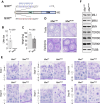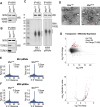MIWI N-terminal arginines orchestrate generation of functional pachytene piRNAs and spermiogenesis
- PMID: 38520410
- PMCID: PMC11194079
- DOI: 10.1093/nar/gkae193
MIWI N-terminal arginines orchestrate generation of functional pachytene piRNAs and spermiogenesis
Abstract
N-terminal arginine (NTR) methylation is a conserved feature of PIWI proteins, which are central components of the PIWI-interacting RNA (piRNA) pathway. The significance and precise function of PIWI NTR methylation in mammals remains unknown. In mice, PIWI NTRs bind Tudor domain containing proteins (TDRDs) that have essential roles in piRNA biogenesis and the formation of the chromatoid body. Using mouse MIWI (PIWIL1) as paradigm, we demonstrate that the NTRs are essential for spermatogenesis through the regulation of transposons and gene expression. The loss of TDRD5 and TDRKH interaction with MIWI results in attenuation of piRNA amplification. We find that piRNA amplification is necessary for transposon control and for sustaining piRNA levels including select, nonconserved, pachytene piRNAs that target specific mRNAs required for spermatogenesis. Our findings support the notion that the vast majority of pachytene piRNAs are dispensable, acting as self-serving genetic elements that rely for propagation on MIWI piRNA amplification. MIWI-NTRs also mediate interactions with TDRD6 that are necessary for chromatoid body compaction. Furthermore, MIWI-NTRs promote stabilization of spermiogenic transcripts that drive nuclear compaction, which is essential for sperm formation. In summary, the NTRs underpin the diversification of MIWI protein function.
© The Author(s) 2024. Published by Oxford University Press on behalf of Nucleic Acids Research.
Figures







Update of
-
MIWI arginines orchestrate generation of functional pachytene piRNAs and spermiogenesis.bioRxiv [Preprint]. 2024 Jan 1:2023.12.31.573779. doi: 10.1101/2023.12.31.573779. bioRxiv. 2024. Update in: Nucleic Acids Res. 2024 Jun 24;52(11):6558-6570. doi: 10.1093/nar/gkae193. PMID: 38260298 Free PMC article. Updated. Preprint.
Similar articles
-
MIWI arginines orchestrate generation of functional pachytene piRNAs and spermiogenesis.bioRxiv [Preprint]. 2024 Jan 1:2023.12.31.573779. doi: 10.1101/2023.12.31.573779. bioRxiv. 2024. Update in: Nucleic Acids Res. 2024 Jun 24;52(11):6558-6570. doi: 10.1093/nar/gkae193. PMID: 38260298 Free PMC article. Updated. Preprint.
-
MIWI N-terminal RG motif promotes efficient pachytene piRNA production and spermatogenesis independent of LINE1 transposon silencing.PLoS Genet. 2023 Nov 13;19(11):e1011031. doi: 10.1371/journal.pgen.1011031. eCollection 2023 Nov. PLoS Genet. 2023. PMID: 37956204 Free PMC article.
-
Mitochondrial membrane-based initial separation of MIWI and MILI functions during pachytene piRNA biogenesis.Nucleic Acids Res. 2019 Mar 18;47(5):2594-2608. doi: 10.1093/nar/gky1281. Nucleic Acids Res. 2019. PMID: 30590800 Free PMC article.
-
Noncanonical functions of PIWIL1/piRNAs in animal male germ cells and human diseases†.Biol Reprod. 2022 Jul 25;107(1):101-108. doi: 10.1093/biolre/ioac073. Biol Reprod. 2022. PMID: 35403682 Review.
-
The regulatory functions of piRNA/PIWI in spermatogenesis.Yi Chuan. 2017 Aug 20;39(8):683-691. doi: 10.16288/j.yczz.17-245. Yi Chuan. 2017. PMID: 28903896 Review.
Cited by
-
Recent advances of PIWI-interacting RNA in cardiovascular diseases.Clin Transl Med. 2024 Aug;14(8):e1770. doi: 10.1002/ctm2.1770. Clin Transl Med. 2024. PMID: 39083321 Free PMC article. Review.
-
piR-38,736 promotes gastric cancer cell proliferation by downregulating SMAD4 expression.J Mol Histol. 2025 Apr 3;56(2):128. doi: 10.1007/s10735-025-10412-8. J Mol Histol. 2025. PMID: 40178733 Free PMC article.
References
-
- Ozata D.M., Gainetdinov I., Zoch A., O’Carroll D., Zamore P.D. PIWI-interacting RNAs: small RNAs with big functions. Nat. Rev. Genet. 2019; 20:89–108. - PubMed
-
- Aravin A.A., Hannon G.J., Brennecke J. The piwi-piRNA pathway provides an adaptive defense in the transposon arms race. Science. 2007; 318:761–764. - PubMed
-
- Deng W., Lin H. miwi, a murine homolog of piwi, encodes a cytoplasmic protein essential for spermatogenesis. Dev. Cell. 2002; 2:819–830. - PubMed
MeSH terms
Substances
Grants and funding
LinkOut - more resources
Full Text Sources

